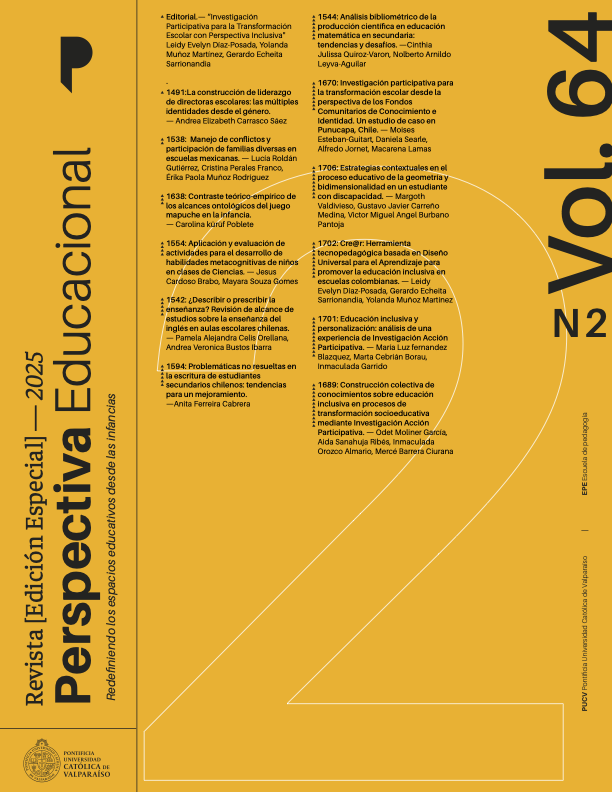Unresolved problems in the writing of chilean high school students: trends for improvement
DOI:
https://doi.org/10.4151/07189729-Vol.64-Iss.2-Art.1594Keywords:
Writing language teaching secondary education spelling applied linguisticsAbstract
In the Chilean educational field, there is a research and educational gap in high school education around the delimitation of the real competencies and linguistic precision evidenced in the use of the written language. Writing review is a very arduous task for teachers, which involves a lot of work, with worrying difficulties and low levels of linguistic and discursive competence observed in students. The purpose of this article is to determine the most relevant problems in the writing of second-year high school students belonging to 4 municipal schools in the Biobío region. It is about answering the question: What are the most frequent errors observed in a corpus of high school learners?
The research is novel since it incorporates the Corpus Linguistics of Language Learners methodology and a technology-assisted error analysis for the identification of errors. Learner corpora are collections of oral texts or digital writings of language learners. These corpora are implemented and processed computationally through specialized programs for the recovery of information according to certain search criteria. The need to observe how students use the language can yield results that show which areas present greater difficulty, which are persistent, or which respond to different phenomena within the development of the language.
The study is mixed descriptive, quantitative and qualitative. The main objective is to determine the most frequent errors observed in a textual corpus of high school students of the educational system. The results show the following most relevant trends: (1) omission of the comma in sentences, (2) omission of the accent in agudas words, (3) in esdrújula words, (4) in the dieretic accent and (5) diacritic, (6) alternation of the graphemes s/c/z, (7) omission of capital letters, (8) substitution of additive connectors y (9) omission of the grapheme h. These trends serve as guidelines for teachers to develop writing proposals that support the improvement of errors in textual revisions and the linguistic precision of students.
The texts analyzed in our research also show different levels of difficulties that in some cases compromise the understanding of the text, such as, for example, what was found at the level of discursive cohesion. The most revealing thing in this study are the problems at the level of spelling and punctuation that could be expected to have already been resolved in the high school education. Orthographic knowledge influences textual construction processes in general, since attention is paid to the way a word is written.
The computational processing of large quantities of student texts to determine with certainty the reality they present at the level of their linguistic and textual competences is configured in a methodological advance at the level of the research that is being carried out around the detection of errors and problems in the educational system. This methodological approach constitutes a contribution to the educational and linguistic area, in that it allows diagnosing and assisting in the text revision tasks by high school teachers. This also provides possibilities for methodological improvements in a context where the detection of errors and the motivation for self-correction can be carried out privately and non-invasively.
References
Agencia de Calidad de la Educación. (2015). Informe de Resultados de Aprendizaje Escritura 2014. Sexto Básico. Ministerio de Educación de Chile. http://archivos.agenciaeducacion.cl/resultados2014/Sintesis_Resultados_6B_Escritura_2014.pdf
Agencia de Calidad de la Educación. (2016). Informe de Resultados de Aprendizaje Escritura 2015. Sexto Básico. Ministerio de Educación de Chile. https://es.scribd.com/document/325368855/Simce-Escritura
Agencia de Calidad de la Educación. (2017). Informe de Resultados de Aprendizaje Escritura 2016. Sexto Básico. Ministerio de Educación de Chile. http://archivos.agenciaeducacion.cl/resultados_nacionales_es- critura_2016.pdf.
Agencia de Calidad de la Educación. (2024). Ajustes al Plan de Evaluaciones Nacionales e Internacionales 2021-2026. Ministerio de Educación de Chile. https://www.agenciaeducacion.cl/sin-categoria/ministerio-de-educacion-anuncia-ajustes-al-plan-de-evaluaciones-2024-2026/
Bañales, G., Ahumada, S., Martínez, R., Martínez, M., & Messina, P. (2018). Investigaciones de la escritura en la educación básica en Chile: Revisión de una década (2007-2016). RLA. Revista de Lingüística Teórica y Aplicada, 56(1), 59-84. https://doi.org/10.4067/S0718-48832018000100059
Camps, A., Milian, M., Bigas, M., Camps, M., & Cabré, P. (2007). La enseñanza de la ortografía. Graó.
Díaz Perea, M. R., & Manjón-Cabeza Cruz, A. (2014). Proceso de construcción ortográfica de las mayúsculas en Educación Primaria. Aula Abierta, 42(02), 71-76. https://doi.org/10.17811/rifie.42.02.2014.71-76
Errázuriz, M. C. (2019). Desempeño escrito de estudiantes de programas de formación inicial docente: ¿Cómo es la calidad del proceso de escritura de sus ensayos? Lengua y Habla, (23), 224-242.
Errázuriz, M. C., Arriagada, L., Contreras, M., & López, C. (2015). Diagnóstico de la escritura de un ensayo de alumnos novatos de Pedagogía en el campus Villarrica UC, Chile. Perfiles Educativos, 37(150), 76-90. https://doi.org/10.22201/iisue.24486167e.2015.150.53163
Fernández-Rufete, A. (2015). Enseñanza de la ortografía, tratamiento didáctico y consideraciones de los docentes de Educación Primaria de la provincia de Almería. Investigaciones Sobre Lectura, 4, 7-24. https://doi.org/10.24310/revistaisl.vi4.10964
Ferreira, A., Villagra, E., & Elejalde, J. (2023). Carencias en el uso de la coma en la producción escrita de estudiantes chilenos de segundo año de educación media. Boletín De Filología, 58(2), pp. 290–318. https://boletinfilologia.uchile.cl/index.php/BDF/article/view/73294
Ferreira, A., Blanco, L., & Elejalde, J. (2023). Dificultades en la precisión ortográfica de palabras agudas en la escritura académica de estudiantes del sistema educacional chileno. Revista Sophia Austral, 29. https://doi.org/10.22352/SAUSTRAL20232904
Ferreira, A. (2022). La precisión gramatical en un corpus de escritura académica de aprendientes africanos de ELE. Revista Internacional de Lenguas Extranjeras, 18, 77-101, https://raco.cat/index.php/RILE/article/view/411731
Ferreira, A. (2017). El Efecto del Feedback Correctivo Escrito Metalingüístico en el Corto y Largo Plazo para Mejorar la Precisión Lingüística en la Destreza Escrita en ELE. Colombian Applied Linguistics Journal, 19(1), pp. 37-50. https://revistas.udistrital.edu.co/ojs/index.php/calj/article/view/10220
Ferreira, A., Elejalde, J., & Blanco, L. (2022). Diseño e implementación del Corpus de Aprendientes de Español como Lengua Extranjera (CAELE). Círculo de Lingüística Aplicada a la Comunicación, 90, 137-154. https://revistas.ucm.es/index.php/CLAC/article/view/71174/4564456560238
Ferreira, A., & Elejalde, J. (2020). Propuesta de una taxonomía etiológica para etiquetar errores de interlengua en el contexto de un corpus escrito de aprendientes de ELE. Forma y Función, 33(1), 115-146. https://doi.org/10.15446/fyf.v33n1.84182
Ferris, D., & Kurzer, K. (2019). Does Error Feedback Help L2 Writers?: Latest Evidence on the Efficacy of Written Corrective Feedback. En K. Hyland, & F. Hyland (Eds.), Feedback in Second Language Writing: Contexts and Issues (pp. 106-124). Cambridge Applied Linguistics. Cambridge University Press. https://doi.org/10.1017/9781108635547.008
Loureda Lamas, Ó., & Acín Villa, E. (2010). Los estudios sobre marcadores del discurso en español, hoy. Arco/libros.
Morales, O., & Hernández, L. (2004). Estudio descriptivo del uso de la ortografía de los estudiantes universitarios de nuevo ingreso. Kaleidoscopio, 2, 151-159.
Ministerio de Educación de Chile. (2017). Lengua y Literatura. Programa de Estudio Segundo medio. Unidad de Currículum y Evaluación. Gobierno de Chile. https://www.curriculumnacional.cl/614/articles-34446_programa.pdf
Ministerio de Educación de Chile. (2019a). Plan de Escritura Nacional. Unidad de Currículum y Evaluación. Gobierno de Chile.
Ministerio de Educación de Chile. (2019b). Currículum Nacional. Unidad de Currículum y Evaluación. Gobierno de Chile.
O’Donnell, M. (2022). UAM Corpus Tool, 6.2 [software]. http://www.corpustool.com/index.html
Real Academia Española. (2011). Ortografía de la Lengua Española. Espasa.
Robinson, P., Mackey, A., Gass, S., & Schmidt, R. (2012). Attention and awareness in Second language acquisition. En S. M. Gass, & A. Mackey (Eds.), The Routledge Handbook of Second Language Acquisition (pp. 247-267). Routledge.
Rodríguez, F., & Sánchez, J. (2018). El desarrollo de la competencia ortográfica en estudiantes de educación secundaria. Cuadernos de Lingüística Hispánica, 31, 153-171. https://doi.org/10.19053/0121053X.n31.2018.6095
Sotomayor, C., Ávila Reyes, N., Bedwell, P., Domínguez, A., Gómez, G., & Jéldrez, E. (2017). Desempeño ortográfico de estudiantes chilenos: Claves para la enseñanza de la ortografía. Estudios Pedagógicos, 43(2), 315-332. https://doi.org/10.4067/S0718- 07052017000200017
Sotomayor, C., Molina, D., Bedwell, P., & Hernández, C. (2013). Caracterización de problemas ortográficos recurrentes en alumnos de escuelas municipales chilenas de 3º, 5º y 7º básico. Revista Signos, 46(81), 105-131. https://dx.doi.org/10.4067/S0718-09342013000100005
Zorraquino, M. A., & Portolés, J. (1999). Los marcadores del discurso. En I. Bosque, & V. Demonte (Coords.), Gramática descriptiva de la lengua española (vol. 3, pp. 4051- 4213). Espasa-Calpe.
Downloads
Published
How to Cite
Issue
Section
License
Copyright (c) 1969 Anita Ferreira Cabrera

This work is licensed under a Creative Commons Attribution-ShareAlike 4.0 International License.
The authors grant an exclusive licence, without time limit, for the manuscript to be published in the Perspectiva Educacional journal, published by the Pontificia Universidad Católica of Valparaíso (Chile), through the School of Pedagogy.





